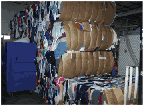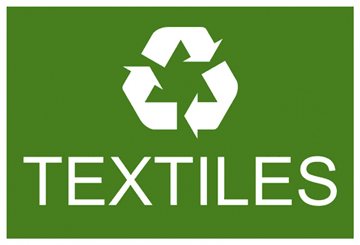 |
RECYCLING TEXTILES!
By Patricia Griffin, President, GHA
I attended the Re-Think Waste Massachusetts recycling meeting, and was absolutely blown away by a session on textile recycling. Im sharing with you what I learned, and hope you too will consider making textile recycling as important as we all make paper, aluminum, plastic and glass recycling.
Fleece, flannel, corduroy, cotton, nylon, denim, wool and linen. What can you do with these fibers when youre finished wearing them, sleeping on them or draping them over your windows? One way to benefit both your community and the environment is to donate used textiles to charitable organizations. Most recovered household textiles end up at these organizations. The remainder go to either a textile recovery facility or the landfill.

Textile recycling seems to be forgotten among its more strongly recycled cousinspaper, aluminum, plastic, glass, etc. Yet textiles are at least 95% recyclable. Currently, only about 15% of textiles are being recycled, so we have a lot of work to do in informing the public and businesses (including hotels) about recycling textiles. First of all, textiles are any fabricso that means clothing, accessories, outer wear, underwear, rugs, draperies, bed and bath linens, table linens, placemats, rugs, purses, belts, hats, gloves, boots, shoes, scarves, etc. The tiny percentage of textile materials that are disposed of as trash by repurposers are either wet, mildewed or contaminated with oil, paint or another hazardous material.

Lightly Worn: We all know that term, but we all need to forget it because all textiles can be repurposed. The textile repurposing company will sort items into about 300 categories. The second most important and most valuable of these categories will be clothing to be offered for sale in other countries. So, these are then separated according to categories beginning with gender, age, type of clothing, type of fabric and season. Each group of these items will be baled and sold by the ton to vendors around the world. These vendors often have special requests for the textile items they want to offer their customers, and so place specific orders. Some of the most coveted clothing sought are bras and underwear! Who knew? They also desperately want belts, purses, shoes, hats, etc.and all clothing accessories.

Post-Consumer Textile Recycling is one of the oldest, most efficient recycling industries in existence. Clothing recyclers add tremendous value through the labor-intensive sorting, separating and recycling of secondhand clothing into 3 main categories: fibers, reclaimed wipers and used clothing.
The Secondary Materials and Recycled Textiles Association is working to increase the amount of textile waste that can be recovered while developing new uses, products and markets for products derived from pre-consumer and postconsumer textile waste. Key in your zip code at smartasn.org to learn where you can recycle textiles. Also, you can use earth911.com to determine where in your zip code you can recycle anything.
Textile recovery facilities separate overly worn or stained clothing into a variety of categories. Based on data from the Council for Textile Recycling, it was estimated that 1.3 million tons of clothing textiles were recovered for recycling in 2009. Some recovered textiles become wiping and polishing cloths. Cotton can be made into rags or form a component for new high-quality paper. Knitted or woven woolens and similar materials are pulled into a fibrous state for reuse by the textile industry in low-grade applications, such as car insulation or seat stuffing. Other types of fabric can be reprocessed into fibers for upholstery, insulation and even building materials. Buttons and zippers are stripped off for reuse. Very little is left over at the end of the recycling process. The remaining natural materials, such as various grades of cotton, can be composted.
For the first time ever, clothing brands, retailers, consumers, municipalities, charitable organizations, academics, hotels and recyclers are joining forces to promote the recycling of clothing and textiles. The Council for Textile Recycling (CTR) (weardonaterecycle.org) recently released its new website aimed at educating the public on the importance of recycling all clothing and textiles, not just those that are gently worn.
In the US, the EPA estimates more than 25 billion pounds of clothing and textiles including clothing, linens, belts and shoes are generated annually. The agency also reports more than 21 billion pounds of post-consumer textile waste ends up in landfills every year.
To see the full-length article in GHA's newsletter, click here.
To learn more about GHA
and how your property can be greener,
jump to Green Hotels Association!
or CALL 713/789-8889 TODAY!
|

GREEN IDEA!
 How about a heartwarming hospitality story? Staff at a Hyatt in Australia wanted to help reforest a nearby national forest that had experienced a devastating forest fire. So they planted 500 native trees in gallon milk jugs on the hotels roof!
How about a heartwarming hospitality story? Staff at a Hyatt in Australia wanted to help reforest a nearby national forest that had experienced a devastating forest fire. So they planted 500 native trees in gallon milk jugs on the hotels roof!







|
 |


